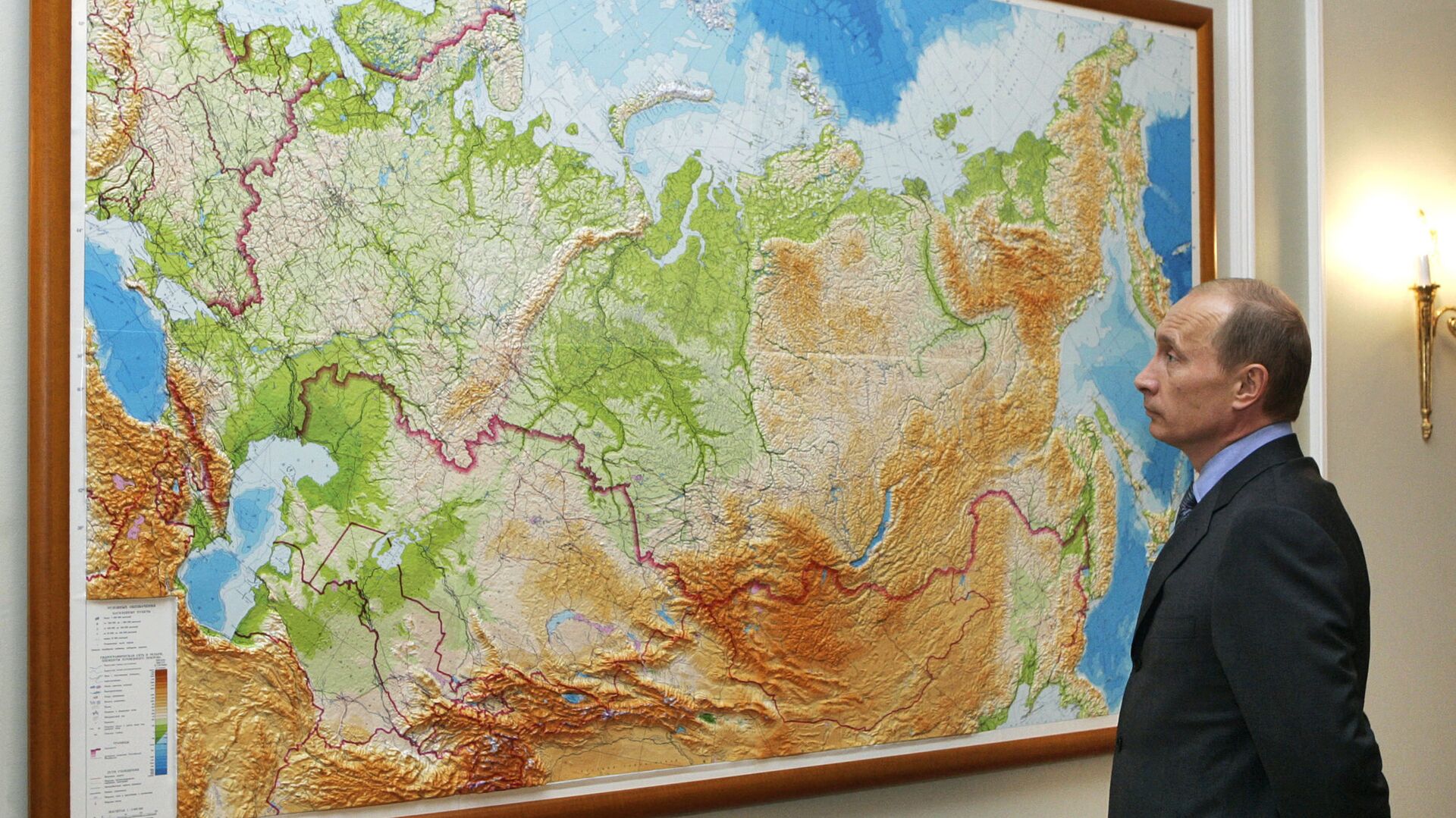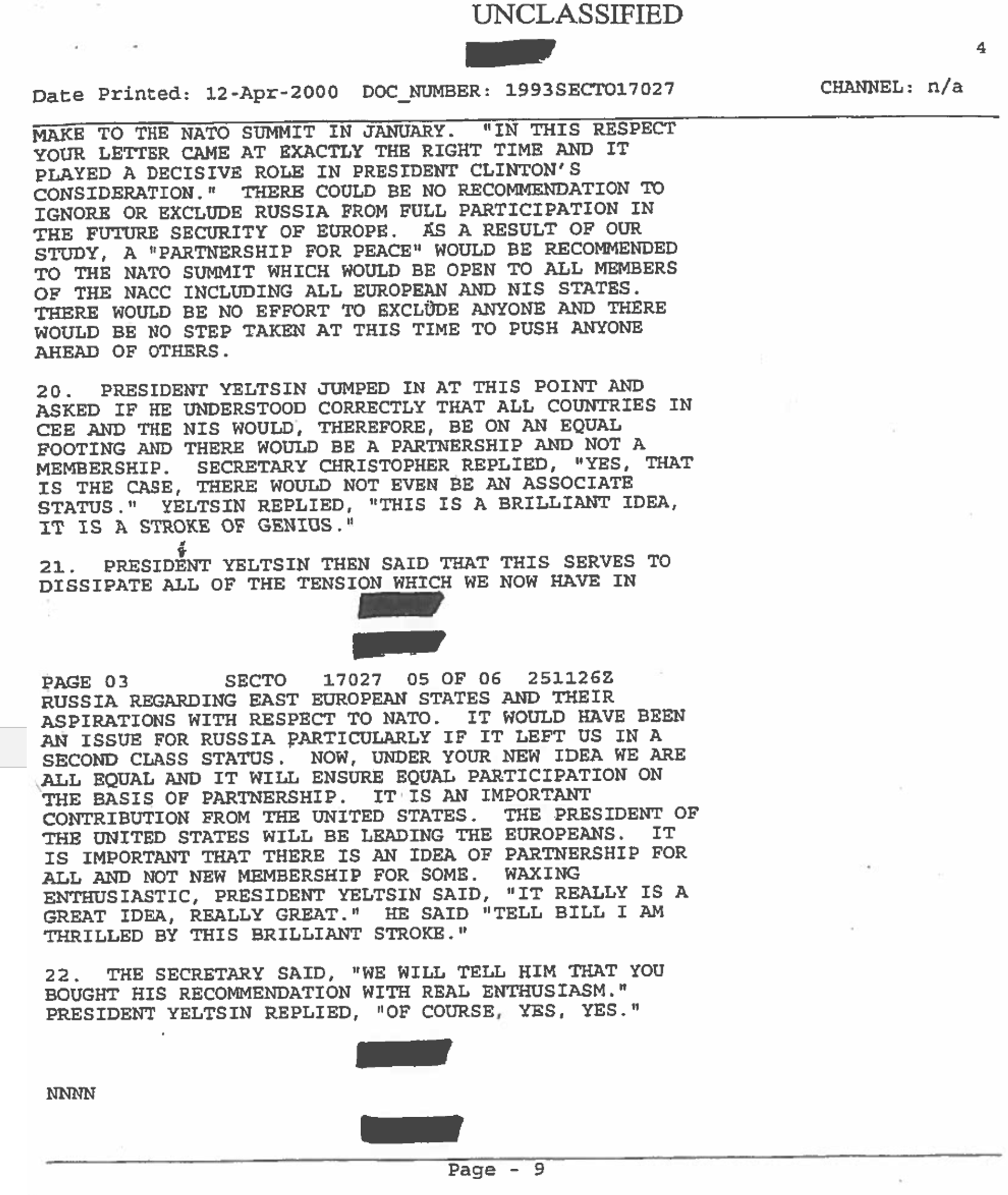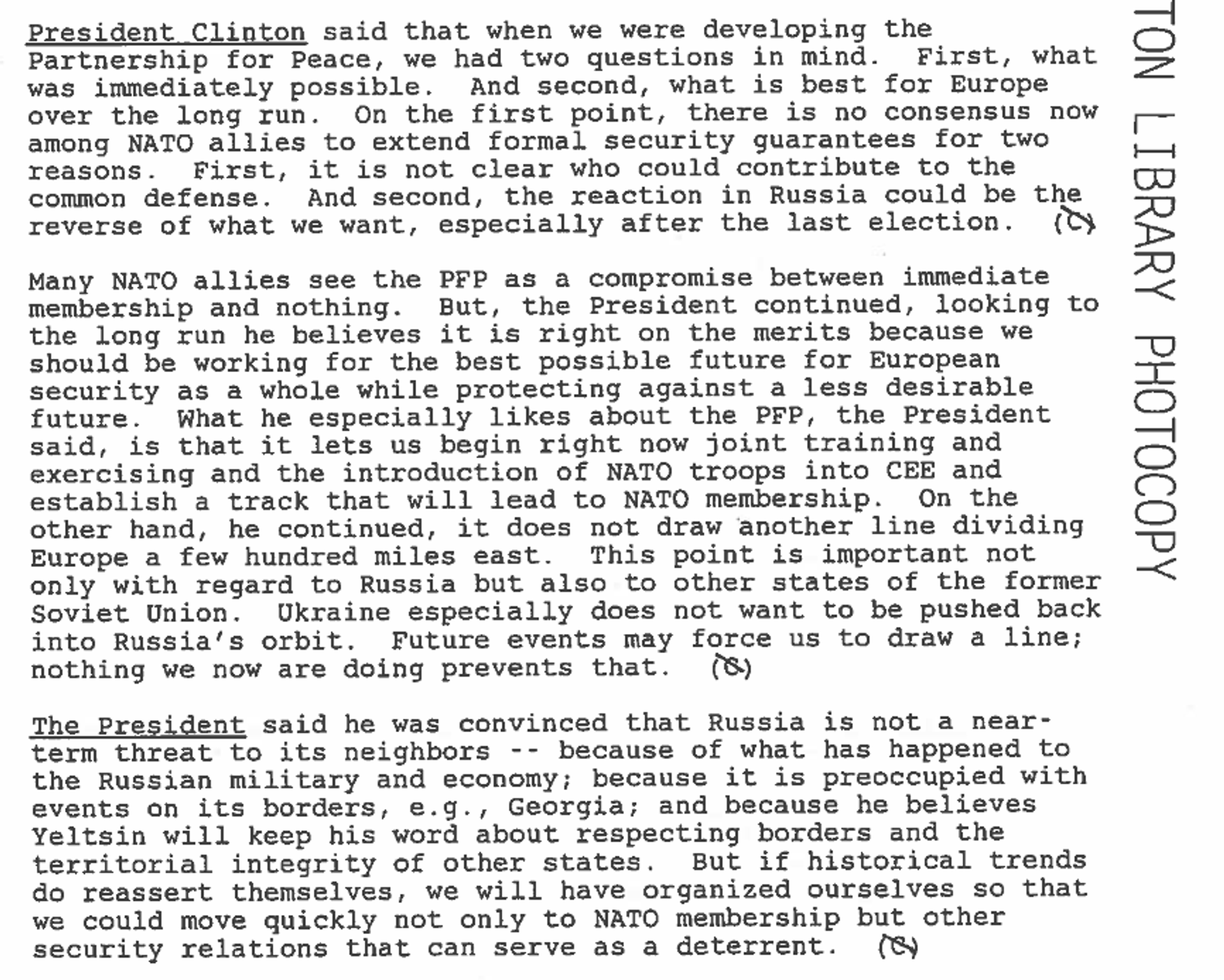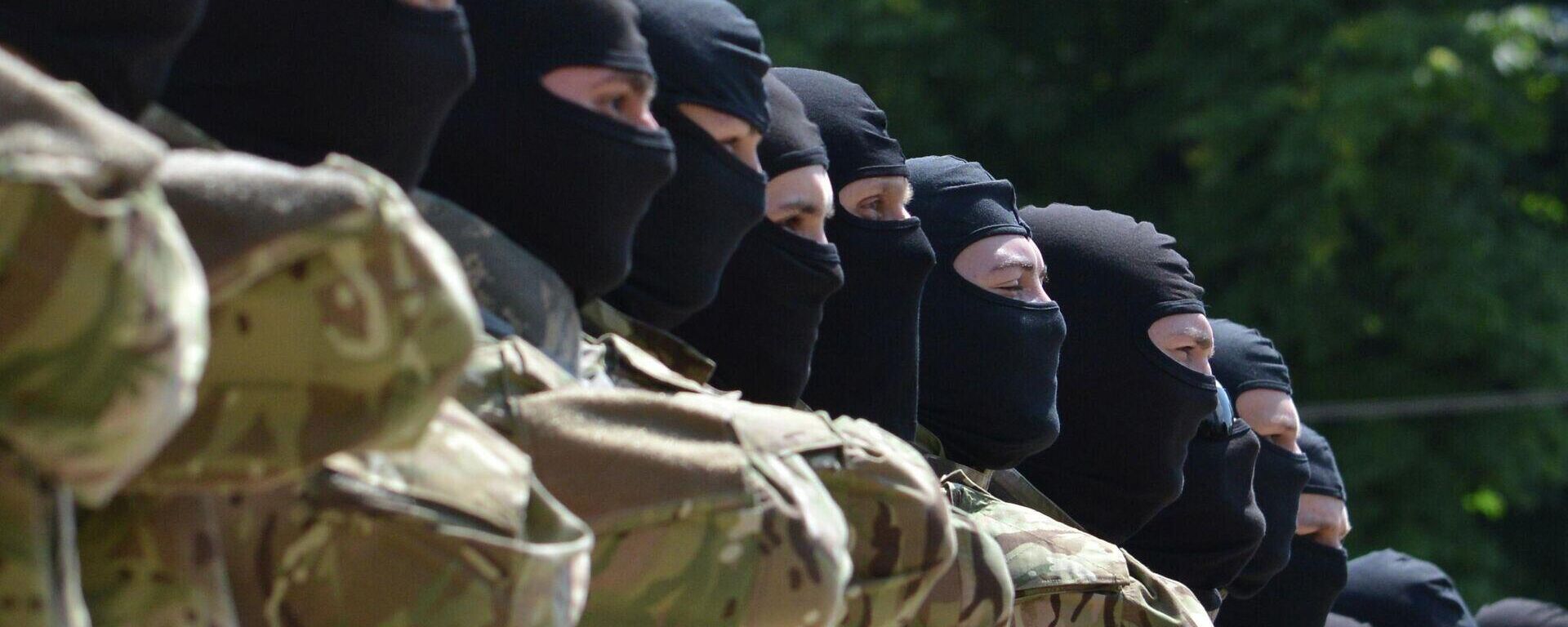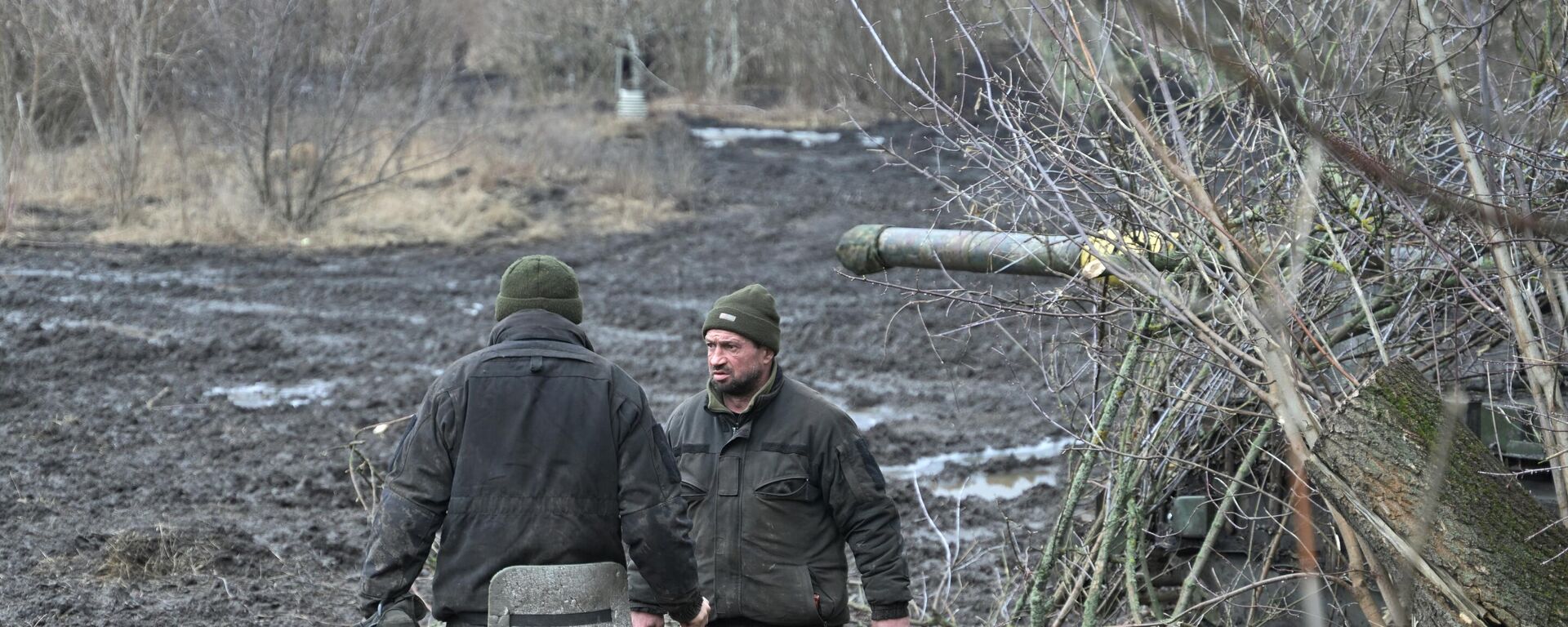https://sputnikglobe.com/20240208/how-natos-obsession-with-ukraine-transformed-into-existential-threat-to-russian-heartland-1116674539.html
How NATO’s Obsession With Ukraine Transformed Into Existential Threat to Russian Heartland
How NATO’s Obsession With Ukraine Transformed Into Existential Threat to Russian Heartland
Sputnik International
Thursday is the 30th anniversary of Ukraine’s membership in the ‘Partnership for Peace’ program, a NATO initiative ostensibly designed to foster ‘trust and cooperation’ between former Soviet bloc nations and the Western alliance. How did the PfP help set the stage for the current security crisis? Sputnik investigates.
2024-02-08T19:36+0000
2024-02-08T19:36+0000
2024-02-08T19:43+0000
analysis
nato
european union (eu)
eurasian economic union
moscow
russia
ukraine
earl rasmussen
boris yeltsin
bill clinton
https://cdn1.img.sputnikglobe.com/img/103414/81/1034148146_0:254:2501:1660_1920x0_80_0_0_63aca9dd59194f181a343474d1158c15.jpg
Ukraine became one of the first countries in Eastern Europe to join the Partnership for Peace program, doing so on February 8, 1994. The program was the brainchild of the Clinton administration, which began plotting ambitious eastward NATO expansion almost immediately after entering office in 1993. But to the Russians and President Boris Yeltsin, the PfP was sold by Clinton Secretary of State Warren Christopher as a potential alternative, rather than a precursor, to NATO membership.“Yes, that is the case, there would not even be an associate status,” Christopher assured Yeltsin at a meeting in Moscow on October 22, 1993, when queried by the Russian president on the issue. “This is a brilliant idea, it is a stroke of genius!” Yeltsin excitedly replied, stressing that the PfP would to dissipate “tensions” within Russia regarding NATO’s future plans for Eastern Europe, and fears that Moscow in this situation would be left “in a second class status.”Christopher would later claim that Yeltsin didn’t understand him, possibly because he was inebriated, and alleged that Yeltsin’s foreign minister, Andrei Kozyrev, failed to explain to the Russian leader that Partnership for Peace could actually lead to NATO membership.In January 1994, before arriving in Moscow for talks with Yeltsin, and less than a month before Ukraine and other countries in Eastern Europe would be invited into the PfP, Clinton met with the leaders of the Czech Republic, Poland and Hungary, confirming that the program could ultimately lead in entry into the alliance.“What he especially likes about the PfP, the president said, is that it lets us begin right now joint training and exercising and the introduction of NATO troops into Central and Eastern Europe and establish a track that will lead to NATO membership,” Clinton was paraphrased as saying in a declassified summary of a January 11, 1994 meeting in Prague with Czech President Vaclav Havel. “On the other hand, he continued, it does not draw another line dividing Europe a few hundred miles east. This point is important not only with regard to Russia but also to other states of the former Soviet Union,” a summary said.Former Clinton Defense Secretary William Perry has expressed regret over the administration’s “rapid expansion of NATO” after 1996, rather than continuing on with the Partnership for Peace program of cooperation without the prospect of joining the alliance in the medium term.UkraineNowhere were Perry’s words about Russian concerns regarding “proposed changes on its borders” more acute than in Ukraine – a country with which Russia shared over 300 years of common history, along with extremely close economic, cultural, religious, and even blood ties.“If we look at it from a historical perspective, the US has always had an interest in Ukraine, and primarily it was a mechanism to ‘disrupt’ the Soviet Union,” Earl Rasmussen, a retired US Army Lieutenant Colonel-turned international affairs observer, told Sputnik.This process continued into the post-Cold War period, Rasmussen noted, recalling the 2004-2005 US and EU-backed Orange Revolution, the 2008 announcement at NATO’s Bucharest Summit opening up dialogue on Ukrainian membership in NATO, and the fundamental policy objectives outlined by leading neocon thinkers in the US foreign policy establishment about preventing Russia’s resurgence and using Ukraine as a battering ram to do so.The former Army officer pointed specifically to Zbigniew Brzezinski’s Grand Chessboard, a 1997 treatise in which the former Carter National Security Advisor outlined the importance of preventing Ukraine from reintegrating economically and politically with Russia.Russia began an ambitious process to incorporate Ukraine into the Eurasian Economic Union in the winter of 2013, offering Kiev a $15 billion Eurobond loan, and slashing gas prices after President Yanukovych rejected an association agreement with the European Union in favor of closer ties with Russia. This ultimately culminated in EU and US forces plotting a coup, ousting Yanukovych and triggering a civil war in the Donbass.Ukraine has no “strategic value” as far as the defense of Europe or the United States are concerned, Rasmussen stressed, with its only use being to pursue the centuries-old imperative of “weaken[ing] Russia as a nation state.”That’s not to mention the economic investments Western countries and corporations have been making in Ukraine, including the buying up of Ukraine’s unique-in-the-world chernozem farmland, “large portions” of which are “now privately held” by Western concerns.Finally, “now you’ve got the whole discussion of moving in with defense companies to establish a presence in there. [European Commission President Ursula] von der Leyen just the other day said that we’re going to integrate Ukraine defense into the ‘greater European defense structure’. They’re still looking at Ukraine as a mechanism to weaken Russia and to ultimately get Russian resources I think as well,” Rasmussen said, noting that a bonus of a weakened Russia would be a potential means to strike the final blow in “containing” China.Fortunately for Moscow, Rasmussen says, is the fact that the US military resources in support of Ukraine are approaching depletion, while Washington faces far more pressing problems at home, ranging from border security to healthcare and infrastructure. Despite these issues, “we’re pumping tens of billions of dollars over to Ukraine in a losing cause. Russia’s won this militarily, all we are doing is extending the war and basically sacrificing hundreds of thousands – a generation of young Ukrainians. This is the result of Western ambitions,” Rasmussen lamented.NATO Threat to ‘Russian Heartland’Mikael Valtersson, a former officer of the Swedish Armed Forces, former defense politician and chief of staff of the Sweden Democrats, agrees that Russia has reason to see a Ukraine affiliated with NATO as an existential threat.Neither post-Soviet Russia nor NATO find it acceptable for Ukraine to be “too aligned with the other site,” Valtersson said, with the pro-Western politicians in Ukraine, “together with some Western interests,” working to try to drag the country into the Western bloc, “even though half of the population was against this. This was also a very risky endeavor since everybody knew this was a threat to Russian core security interests,” culminating in the crisis facing the region today.Asked how far the US and NATO will be willing to go to absorb Ukraine into the alliance, Valtersson said it depends on the outcome of the current conflict.
https://sputnikglobe.com/20220304/why-is-the-west-silent-about-ukrainian-neo-nazi-movements-azov-battalion--bandera-legacy-1093561142.html
https://sputnikglobe.com/20231208/biolabs-at-work-antimicrobial-resistance-sees-alarming-spike-in-ukraine---cdc-1115477113.html
https://sputnikglobe.com/20240208/ukrainian-armed-forces-experiencing-acute-shortage-of-infantry-morale-falling---report-1116660733.html
moscow
russia
ukraine
Sputnik International
feedback@sputniknews.com
+74956456601
MIA „Rosiya Segodnya“
2024
News
en_EN
Sputnik International
feedback@sputniknews.com
+74956456601
MIA „Rosiya Segodnya“
Sputnik International
feedback@sputniknews.com
+74956456601
MIA „Rosiya Segodnya“
how did bill clinton sow seeds for ukrainian crisis, what is nato's partnership for peace program, ukraine, russia, soviet union, nato, west
how did bill clinton sow seeds for ukrainian crisis, what is nato's partnership for peace program, ukraine, russia, soviet union, nato, west
How NATO’s Obsession With Ukraine Transformed Into Existential Threat to Russian Heartland
19:36 GMT 08.02.2024 (Updated: 19:43 GMT 08.02.2024) Thursday is the 30th anniversary of Ukraine’s membership in the ‘Partnership for Peace’ program, a NATO initiative ostensibly designed to foster ‘trust and cooperation’ between former Soviet bloc nations and the Western alliance. How did the PfP help set the stage for the current security crisis? Sputnik investigates.
Ukraine became one of the first countries in Eastern Europe to join the Partnership for Peace program, doing so on February 8, 1994. The program was the brainchild of the Clinton administration, which began plotting ambitious eastward NATO expansion almost immediately after entering office in 1993. But to the Russians and President Boris Yeltsin, the PfP was sold by Clinton Secretary of State Warren Christopher as a potential alternative, rather than a precursor, to NATO membership.
“Yes, that is the case, there would not even be an associate status,” Christopher assured Yeltsin at a meeting in Moscow on October 22, 1993, when queried by the Russian president on the issue. “This is a brilliant idea, it is a stroke of genius!” Yeltsin excitedly replied, stressing that the PfP would to dissipate “tensions” within Russia regarding NATO’s future plans for Eastern Europe, and fears that Moscow in this situation would be left “in a second class status.”
Christopher
would later claim that Yeltsin didn’t understand him, possibly
because he was inebriated, and alleged that Yeltsin’s foreign minister, Andrei Kozyrev, failed to explain to the Russian leader that Partnership for Peace
could actually lead to NATO membership.
In January 1994, before arriving in Moscow for talks with Yeltsin, and less than a month before Ukraine and other countries in Eastern Europe would be invited into the PfP, Clinton
met with the leaders of the Czech Republic, Poland and Hungary, confirming that the program could ultimately lead in entry into the alliance.
“What he especially likes about the PfP, the president said, is that it lets us begin right now joint training and exercising and the introduction of NATO troops into Central and Eastern Europe and establish a track that will lead to NATO membership,” Clinton was paraphrased as saying in a declassified summary of a January 11, 1994 meeting in Prague with Czech President Vaclav Havel. “On the other hand, he continued, it does not draw another line dividing Europe a few hundred miles east. This point is important not only with regard to Russia but also to other states of the former Soviet Union,” a summary said.
Former Clinton Defense Secretary William Perry has
expressed regret over the administration’s “rapid expansion of NATO” after 1996, rather than continuing on with the Partnership for Peace program of cooperation without the prospect of joining the alliance in the medium term.
“Russia expressed its objections to the proposed changes on its borders, but its views were ignored,” Perry wrote in September 2022 op-ed, after the escalation of the Ukrainian crisis. “The combination of the West failing to act during Russia’s [1998] financial crisis, and ignoring their strongly-held views on NATO expansion, reinforced a prevailing Russian belief that we didn’t take them seriously. Indeed, many in the West saw Russia only as the loser of the Cold War, not worthy of our respect,” Perry lamented.
Nowhere were Perry’s words about Russian concerns regarding “proposed changes on its borders” more acute than in Ukraine – a country with which Russia shared
over 300 years of common history, along with extremely close economic, cultural, religious, and even blood ties.
“If we look at it from a historical perspective, the US has always had an interest in Ukraine, and primarily it was a mechanism to ‘disrupt’ the Soviet Union,” Earl Rasmussen, a retired US Army Lieutenant Colonel-turned international affairs observer, told Sputnik.
“If you look back to after World War II, [the US] provided assistance to and funded ultranationalist remnants of Bandera supporters, who collaborated with Germany and basically were a mechanism to antagonize and to promote regime change within the Soviet Union,” Rasmussen recalled, referring to the Organization of Ukrainian Nationalists and the Ukrainian Insurgent Army, which terrorized civilians, administrators, anti-fascist Ukrainians and Red Army soldiers in western Ukraine from the end of World War II into the early 1950s. “They were mostly focused on the revolts in the western area of Ukraine, and so we funded them for years as multiple CIA projects.”
This process continued into the post-Cold War period, Rasmussen noted, recalling the 2004-2005 US and EU-backed Orange Revolution, the 2008 announcement at NATO’s Bucharest Summit opening up dialogue on Ukrainian membership in NATO, and the fundamental policy objectives outlined by leading neocon thinkers in the US foreign policy establishment about preventing Russia’s resurgence and using Ukraine as a battering ram to do so.
The former Army officer pointed specifically to Zbigniew Brzezinski’s Grand Chessboard, a 1997 treatise in which the former Carter National Security Advisor outlined the importance of preventing Ukraine from reintegrating economically and politically with Russia.
“Ukraine, a new and important space on the Eurasian chessboard, is a geopolitical pivot because its very existence as an independent country helps to transform Russia. Without Ukraine, Russia ceases to be a Eurasian empire,” Brzezinski wrote over two-and-a-half decades ago. “However, if Moscow regains control over Ukraine, with its 52 million people and major resources as well as access to the Black Sea, Russia automatically again regains the wherewithal to become a powerful imperial state, spanning Europe and Asia.”
Russia began an ambitious process to incorporate Ukraine
into the Eurasian Economic Union in the winter of 2013, offering Kiev a $15 billion Eurobond loan, and slashing gas prices after President Yanukovych rejected an association agreement with the European Union in favor of closer ties with Russia. This ultimately culminated in EU and US forces plotting a coup, ousting Yanukovych and triggering a civil war in the Donbass.
“I think that’s been an objective for a long time, not just containment, but also access to their resources and everything else,” Rasmussen said, referring to Brzezinski’s logic. “Ukraine was an avenue to get into the heart of Russia as well and to weaken Russia, as well as the resources that Ukraine has. Another key component of this is the naval base in Sevastopol, Crimea. That’s the only warm water port to the Mediterranean that Russia has. Controlling that is another key thing. I think the Obama administration, primarily [assistant secretary of state Victoria] Nuland and probably Mr. Biden, were probably most likely not very pleased when the 2014 coup did not basically capture all their objectives,” the observer noted, pointing to the March 2014 referendum in which Crimea residents voted overwhelmingly to split off from post-Maidan Ukraine and rejoin Russia.
Ukraine has no “strategic value” as far as the defense of Europe or the United States are concerned, Rasmussen stressed, with its only use being to pursue the centuries-old imperative of “weaken[ing] Russia as a nation state.”
“If you look at the resources [the US has] poured in there since 2014, even before 2014 – you had Victoria Nuland back in 2014 saying that they’ve pumped $5 billion into Ukraine to ‘build democratic institutions’. You had a huge number of non-governmental organizations, NGOs,” some of which were “basically avenues for US political influence into the region…After that, especially after 2014, you had a huge amount of funding to go into weapons, military advisors, training of Ukrainian forces. As well as the emergence of what Mrs. Nuland calls ‘bioresearch facilities’,” which Rasmussen pointed out are really just basically bioweapons labs.

8 December 2023, 12:50 GMT
That’s not to mention the economic investments Western countries and corporations have been making in Ukraine, including the buying up of Ukraine’s unique-in-the-world chernozem farmland, “large portions” of which are “now privately held” by Western concerns.
Finally, “now you’ve got the whole discussion of moving in with defense companies to establish a presence in there. [European Commission President Ursula] von der Leyen just the other day said that we’re going to integrate Ukraine defense into the ‘greater European defense structure’. They’re still looking at Ukraine as a mechanism to weaken Russia and to ultimately get Russian resources I think as well,” Rasmussen said, noting that a bonus of a weakened Russia would be a potential means to strike the final blow in “containing” China.
Ultimately, Rasmussen believes that the problem facing the US is that its strategy is guided, sometimes literally, by people who would find themselves more comfortable in the 1980s. “They still have very influential people in the West that for some reason – and I’ve had meetings with some of these people – they still continue to refer to Russia as the Soviet Union. So you still have people in that mindset…You’ve got people whose whole project could have been to take over Russia at some point in time, and Ukraine is just a stepping stone to do that,” he said.
Fortunately for Moscow, Rasmussen says, is the fact that the US military resources in support of Ukraine are approaching depletion, while Washington faces far more pressing problems at home, ranging from border security to healthcare and infrastructure. Despite these issues, “we’re pumping tens of billions of dollars over to Ukraine in a losing cause. Russia’s won this militarily, all we are doing is extending the war and basically sacrificing hundreds of thousands – a generation of young Ukrainians. This is the result of Western ambitions,” Rasmussen lamented.
NATO Threat to ‘Russian Heartland’
Mikael Valtersson, a former officer of the Swedish Armed Forces, former defense politician and chief of staff of the Sweden Democrats, agrees that Russia has reason to see a Ukraine affiliated with NATO as an existential threat.
“From the beginning it was a large asset deep inside the former Soviet sphere of interest, but after the expansion of NATO to include the former Warsaw Pact countries and the Baltic states it became the main buffer zone between NATO and Russia,” Valtersson told Sputnik. “Today a Ukraine within NATO would mean that NATO forces could be placed near many key sites within Russia and Russia would have very limited time to respond to missile strikes toward Moscow and the Russian heartland.”
Neither post-Soviet Russia nor NATO find it acceptable for Ukraine to be “too aligned with the other site,” Valtersson said, with the pro-Western politicians in Ukraine, “together with some Western interests,” working to try to drag the country into the Western bloc, “even though half of the population was against this. This was also a very risky endeavor since everybody knew this was a threat to Russian core security interests,” culminating in the crisis facing the region today.
Asked how far the US and NATO will be willing to go to absorb Ukraine into the alliance, Valtersson said it depends on the outcome of the current conflict.
“In the unlikely event of something that could be seen as a partial Ukrainian victory and a resolution of the territorial question with Russia, Ukraine will probably become a member of NATO. But a more likely outcome, if current trends on the battlefield continue, is that Ukraine will return to a constitutional neutrality as a part of a peaceful resolution of the conflict. NATO has probably realized that they can't have what they aspired to, and will not risk open conflict with Russia to achieve a maximal goal. In the end NATO will accept a smaller and neutral Ukraine,” the observer summed up.
